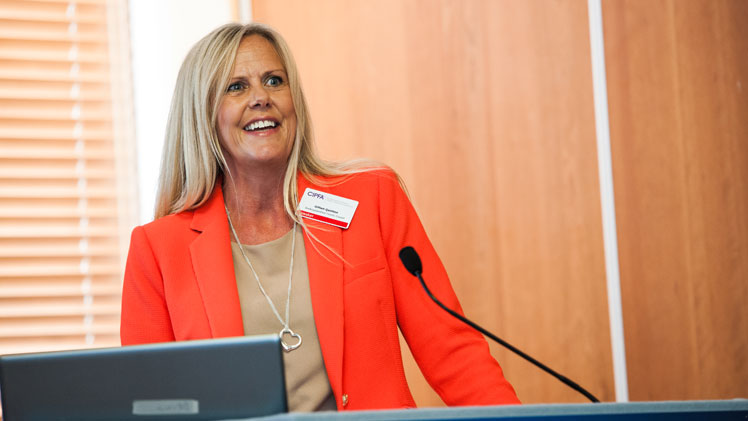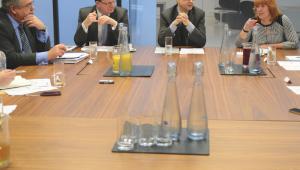When you give money to charity, you hope every pound of your donation will have maximum impact. So said Jonathan Flowers, local government market director at services firm Capita, introducing a workshop at the CIPFA Conference on the future of the corporate centre, sponsored by KBR. “They have contacts, equipment, pre-established relationships, and so on,” he observed, so you can expect more bang for your buck than simply handing cash directly to the needy.
As a result, the best charities can often have higher overheads than less effective ones. It may be counter-intuitive, but research has shown that stripping out administration is not necessarily the best way to achieve overall value for money. However, the notion of avoiding bureaucracy tends to dominate thinking about effectiveness with respect to charities and the public sector alike.
“The negative, deficit model of the corporate centre is very well embedded in the way we think,” Flowers said, noting the current emphasis on front-line services. “In the army, front-line has a very particular meaning, but they don’t talk about things like logistics and signalling and catering as overheads,” he said. “The term they use is ‘force multiplier’, because they multiply the effectiveness of the front-line force.”
So how can an organisation ensure that its corporate centre is actually a lean force multiplier, and not a spare tyre of flab?
Gillian Quinton, managing director for business enterprise and shared services at Buckinghamshire County Council, told delegates at the conference how her organisation had tackled exactly this kind of question.

Gillian Quinton at the CIPFA Conference 2015
“Like all public sector organisations, we’re struggling to balance our books,” she said. “About two years ago we had a new leader elected, who set us a very clear ambition for financial stability and sustainability.” The council had a Revenue Support Grant dependency of about 12%, so it was not unreasonable to suppose it might become self-supporting. “We’re on track to achieve that in the early 2020s,” she said.
“To do this, we needed to think differently about the council as a business. To focus more on commercial development, without losing those really important public-service values,” she recalled. “To do fewer things better, and to be absolutely explicit about our priorities. Which is easier said than done because it’s really tough for politicians to make decisions about stopping doing things.”
The council embraced the force multiplier concept, and applied it in a wholesale reorganisation of its operations. “We took a zero-base approach,” Quinton said – in other words taking a clean sheet and outlining functions that might be effective in driving the desired outcomes and objectives. “We pitched our ideas to each other. It wasn’t scientific but it meant we thought about what those force multiplying functions would be, rather than reconfiguring the organisation that existed.”
The groupings that emerged were:
● Use of assets. “We needed to focus on really strong use of our assets to produce the best return on our investment,” Quinton explained.
● Smart data. “We had lots of information but we weren’t using it effectively to help us make clever decisions,” she said.
● Strategy and policy. The priority here, Quinton said, was to establish clarity about priorities as well as areas where efforts might be wound down.
● Customer insight. “We needed to develop really good insight into what our customers’ needs were,” she said, “across the whole organisation, so that we could commission services more effectively.”
● People and organisational development. This meant a focus on acquiring the skills required for the future, both through training and recruiting people with “a growth mindset”, Quinton said.
● Assurance. “Shifting to more autonomous business units, we needed a good assurance function in the centre to give members the assurance the organisation was being run effectively.”
● Innovation. “To help us develop the culture and drive forward the innovation that we needed.”
Quinton explained that the council developed a written operating framework to glue these elements together: “It’s the contract between the headquarters and the business units,” she said. “The requirements are relaxed as far as possible to give the business units the freedom to be creative and more commercial. But there are a few things that are must-dos and have to be done in a single way, and those are all in the operating framework.”
As a result of the new structure, the division between the corporate centre and its surrounding functions has been dramatically redrawn. “We moved from an HQ that had about 700 people in it, prior to the future-shape model, to a new streamlined HQ that has 77 people in it,” Quinton said. “All the functions still in HQ are considered strong force multipliers for our organisation.”
The primary benefit has been a stronger focus on delivery, but there have also been cost reductions. “We have achieved £1.3m of savings, through redesign, reinvestment and stopping doing some things,” she added.
As with any programme of change, there have been issues. “We had to reduce or stop doing some things to create the resource needed to strengthen others,” Quinton noted. “As a result some functions felt undervalued. They felt if they were no longer in HQ, the function was being devalued, so there was a messaging challenge there.”
Securing buy-in to the force-multiplier concept was tough, too: “At times people struggled to understand the concept and how it was applied, but if you have a clear set of objectives then it’s much easier to apply these concepts,” she said. “What are the things that will really drive forward our ambition? You have to explain very clearly the rationale of the force multiplication model.”
Behind the blue line
In the same conference workshop Anne McMeel, senior advisor at service provider KBR, told delegates about another force-multiplier project undertaken for the Met – the Metropolitan Police Service in London.
Since April 2013, KBR has acted as a property service integrator for the Met using a framework contract which is also available to other members of the GLA Group – the Greater London Authority and related organisations including Transport for London and the London Fire Brigade.
As the MET’s property integrator, KBR’s job is to manage the fulfilment of property contracts between the Met and its various providers. The notion is to let police staff focus on strategy, while KBR works to ensure property services become force multipliers.
“We work behind the blue line, taking all the burdens of back-office, bureaucracy, and helping to change how the Met operates behind the scenes,” McMeel said.
The contract covers all estate management functions, many of which might surprise the average facilities manager – from providing blankets for detainees to cleaning up crime scenes, or bringing in catering facilities and toilets for officers involved in major events such as the Notting Hill Carnival.
One of the ways KBR has improved matters is by opening up the Met’s supply chain, dealing with a wider range of prime contractors, many of which are now specialised small or medium enterprises. This is a change that has “improved operational responsiveness and flexibility”, according to McMeel.
Another significant improvement has been the creation of a single database to consolidate data about the Met’s estate. “Before, information was coming from a number of different suppliers and often there was a dispute about meaning,” she noted.
The resulting “single version of the truth” is helping to inform which properties should be retained, what the investment profile should look like, and how the Met can make good decisions about value for money. “We’re also using it to work with Met staff to ensure optimum use of the estate,” McMeel added.
The Met is part way through a strategic plan to downsize from 600 to 400 properties by 2016, and is on target to reach its goal. “The next phase is being planned and the Met is now looking at what its estate is going to look like to 2020,” she said.
Eighteen months into a 10-year contract, cost reductions have more than covered the cost of KBR’s role as integrator. “The Met has seen savings of some 20% on estate management costs, demonstrating that the service integrator model is not another level of bureaucracy,” McMeel said. “This approach does actually make things work better.”
Download KBR’s white paper: The Service Integrator: Aligning Public Services










